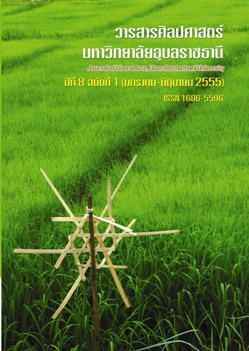Sustainable Cultural Heritage Conservation: Sangkhlaburi District, Kanchanaburi Province
Main Article Content
บทคัดย่อ
The study investigates: (1) the history of Sangkhlaburi district in Kanchanaburi province, (2) the various values both tangible and intangible relating to the historic settings, (3) important cultural resources and (4) the evolution of tourism; it concludes with (5) recommendations for a cultural heritage conservation approach. The researcher used an ethnographic methodology through in-depth interview and related fieldwork for collecting data. Primary data collection focused on the Mon community, Moo 2 in Sangkhlaburi district, in order to analyze the Mon culture and tradition. The secondary data is mostly derived from relevant books, journals and electronic resources. The study found that (1) Sangkhlaburi district’s history is that of a border town in Kanchanaburi province. The Burmese army used the Thai-Burma border at the Three Pagodas Pass to move their army, from the Ayutthaya period to the Rattanagosin period. Burma has a long history of ethnic conflicts as ethnic groups have tried to gain their own independence. As a result, Mon families escaped and have evacuated to Thailand since 1948. Luang Phor Uttama who was an old religious leader helped Mon people to migrate into Thailand. He negotiated with the Thai government to provide residential land for the diaspora Mon. (2) The value of cultural heritage is presented through the architecture and decoration of the Mon buildings as well as their relevant artworks mostly in housing, the temple, and a wooden bridgeas evidence of a civil flourish of Mon architecture and art reminiscent of the previous, albeit imagined, Mon state. The Buddhist influence became a core value of the Mon villagers and has continued its role uninterrupted. The Mon nation converted to Theravada Buddhism at a very early point in their history. (3) Mon villagers have their own cultural resources such as Mon language, dressing, cuisine, music, dance, and traditions. Mon villagers communicate to each other with their Mon language on a daily basis. They also use white shirts and red sarongs as their national clothes. The Mon dance drama is always played here especially at the Loy Krathong festival and the birthday of Luang Phor Uttama. (4) After a launch of the Unseen Thailand Program with a focus on the community’s unusual sunken temple, more and more group tours have been visiting the place. However, tourism created many impacts, both positive and negative, on the locals as well as on their indigenous culture, economic system, and society. The positive impact is mainly from the emergence of new businesses and their generated employment relevant to the tourism in the community and its surroundings. In contrast, the negative impact is mostly from an overdevelopment in the community to support the tourism industry without appropriate planning and control for a sustainable future. Carrying capacity mostly in the high season is the main issue for the site. Moreover, the higher living standard achieved through tourism has been raising the costs of all products and services in the community. Some entrepreneurs and traders in the tourism sector who are external people from outside the community have been maximizing the markup of their products and services being sold to the tourists without necessity. Authenticity of the community is thereby being threatened by tourism. (5) According to best practice observed in Ban Lorcha, Chiengrai province and Ban Jum Rung, Rayong province, the community-based tourism concept and the sufficient economy concept could help create a degree of immunity against outside influences, resulting in long-term survival and more sustainable communities. The Mon community has high potential to be developed as a tourist destination for cultural tourism so that the members of the Mon community should invest their time into planning cultural tourism strategies and utilizing their existing resources consciously, the benefits of which could be stable incomes and more a self-reliant community.
การศึกษาสืบค้น (1) ประวัติศาสตร์อำเภอสังขละบุรี จังหวัดกาญจนบุรี (2)คุณค่าที่หลากหลายทั้งสัมผัสได้และสัมผัสไม่ได้ของสถานที่ตั้งทางประวัติศาสตร์(3) ทรัพยากรทางวัฒนธรรมที่สำคัญ (4) วิวัฒนาการของการท่องเที่ยว (5) คำแนะนำสำหรับวิธีการในการอนุรักษ์สถาปัตยกรรมทางวัฒนธรรม นักวิจัยใช้วิธีการศึกษาชาติพันธุ์วรรณาผ่านการสัมภาษณ์เชิงลึก และลงภาคสนามเพื่อรวบรวมข้อมูล การเก็บข้อมูลปฐมภูมิมุ่งเน้นที่ชุมชนมอญ หมู่ 2 อำเภอสังขละบุรี เพื่อวิเคราะห์วัฒนธรรมและประเพณีมอญ ข้อมูลทุติยภูมิคือส่วนใหญ่มาจากหนังสือวารสารที่เกี่ยวข้องและแหล่งข้อมูลทางอิเล็กทรอนิกส์การศึกษาพบว่า (1) ประวัติศาสตร์อำเภอสังขละบุรีเป็นเมืองชายแดนในจังหวัดกาญจนบุรี กองทัพพม่าใช้เป็นเส้นทางข้ามระหว่างไทยกับเมียนมาร์ที่ด่านเจดีย์สามองค์เพื่อเคลื่อนย้ายกองทัพตั้งแต่สมัยอยุธยาจนถึงสมัยรัตนโกสินทร์ เมียนมาร์มีประวัติศาสตร์ยาวนานในเรื่องความขัดแย้งทางชาติพันธุ์ ตลอดจนกลุ่มชาติพันธุ์พยายามเพื่อจะได้รับอิสรภาพเป็นของกลุ่มตนเอง ส่งผลให้ครอบครัวมอญหนีและอพยพสู่ประเทศไทยตั้งแต่ปี พ.ศ. 2491 หลวงพ่ออุตตะมะเป็นผู้นำ ทางศาสนาได้ช่วยคนมอญอพยพมาสู่ประเทศไทย หลวงพ่อได้เจรจากับรัฐบาลไทยเพื่อยกที่ดินเป็นที่พักอาศัยสำหรับมอญพลัดถิ่น(2) คุณค่าสถาปัตยกรรมทางวัฒนธรรมถูกนำ เสนอผ่านทางสถาปัตยกรรมและการตกแต่งสิ่งก่อสร้างของมอญตลอดจนงานศิลปะที่เกี่ยวข้อง ส่วนใหญ่เป็นการสร้างบ้าน วัด และสะพานไม้ เป็นหลักฐานว่ามีวัฒนธรรมเจริญรุ่งเรืองของสถาปัตยกรรมและศิลปะมอญ ซึ่งเตือนใจให้นึกถึงอดีตที่ผ่านมา ถึงแม้ว่ารัฐมอญจะเป็นเพียงการถูกจินตนาการ อิทธิพลทางพุทธศาสนากลายเป็นคุณค่าที่สำคัญของคนมอญและมีบทบาทต่อเนื่องไม่สามารถมีสิ่งอื่นใดแทรกแซงได้ รัฐมอญเปลี่ยนความเชื่อมานับถือพุทธศานานิกายเถรวาทเป็นจุดยืนที่แสดงอย่างชัดเจนในประวัติศาสตร์(3) คนมอญมีทรัพยากรทางวัฒนธรรมเป็นของตนเอง ได้แก่ ภาษามอญการแต่งกาย อาหาร ดนตรี การเต้นรำ และประเพณี คนมอญสื่อสารระหว่างกันจะใช้ภาษามอญในชีวิตประจำ วัน คนมอญแต่งกายด้วยเสื้อเชิ้ตสีขาวและโสร่งสีแดงเปรียบเป็นชุดประจำ ชาติของมอญ การแสดงเต้นรำ แบบมอญถูกแสดงขึ้นอยู่เสมอโดยเฉพาะในเทศกาลลอยกระทง และวันเกิดหลวงพ่ออุตตะมะ(4) หลังจากที่ปฏิบัติการตามแผนงาน “Unseen Thailand” โดยมุ่งให้ความสำ คัญกับวัดวังวิเวการามเก่าที่จมน้ำในชุมชน กลุ่มทัวร์หลายต่อหลายกลุ่มได้มาเยี่ยมชมสถานที่ แต่อย่างไรก็ตามการท่องเที่ยวทำให้เกิดผลกระทบมากมายทั้งในแง่บวกและแง่ลบให้แก่ชุมชน ตลอดจนวัฒนธรรมพื้นถิ่น ระบบเศรษฐกิจและสังคม ผลกระทบในแง่บวก ส่วนใหญ่มากจากธุรกิจใหม่เกิดขึ้นและการจ้างงานที่เกี่ยวข้องกับการท่องเที่ยวในชุมชนและบริเวณโดยรอบ ในแง่ลบคือส่วนใหญ่มาจากการพัฒนาที่มากเกินไปในชุมชนเพื่อเป็นการสนับสนุนอุตสาหกรรมการท่องเที่ยวโดยปราศจากการวางแผนและการควบคุมที่เหมาะสมที่จะให้เกิดความยั่งยืนในอนาคต ความสามารถในการรองรับส่วนใหญ่ในช่วงฤดูการท่องเที่ยวเป็นประเด็นสำคัญสำหรับสถานที่ ยิ่งไปกว่านั้นอัตราค่าครองชีพที่สูงขึ้นโดยผ่านการท่องเที่ยวเป็นการเพิ่มต้นทุนของสินค้าและบริการทุกอย่างในชุมชน ผู้ประกอบการและผู้ค้าบางรายในภาคส่วนการท่องเที่ยวผู้ซึ่งเป็นบุคคลภายนอกชุมชนเป็นผู้ทำให้สินค้าและบริการได้ราคาขายมากขึ้น ถูกขายให้แก่นักท่องเที่ยวโดยปราศจากความจำเป็น ความแท้จริงของชุมชนกำลังเกิดความเสี่ยงโดยการท่องเที่ยว(5) เนื่องจากสังเกตชุมชนต้นแบบจากบ้านหล่อชา จังหวัดเชียงราย และบ้านจำรุง จังหวัดระยอง แนวคิดการท่องเที่ยวโดยชุมชน และแนวคิดเศรษฐกิจพอเพียงช่วยสร้างภูมิคุ้มกันได้ในระดับหนึ่งในการต่อต้านกับอิทธิพลภายนอก และส่งผลระยะยาวให้กับชุมชนเกิดความยั่งยืนและอยู่รอดได้ ชุมชนมอญมีศักยภาพสูงในการพัฒนาให้เป็นแหล่งท่องเที่ยวสำหรับการท่องเที่ยวทางวัฒนธรรม เพื่อที่ ว่าสมาชิกในชุมชนมอญสามารถลงทุนเวลาในการวางแผนกลยุทธ์การท่องเที่ยวทางวัฒนธรรม และสร้างความตระหนักในการใช้ทรัพยากรที่มีอยู่ให้เกิดคุณค่า ผลประโยชน์ของสิ่งเหล่านี้สามารถสร้างรายได้ที่แน่นอนและชุมชนสามารถพึ่งตนเองได้มากขึ้น
Article Details
บท
Articles

